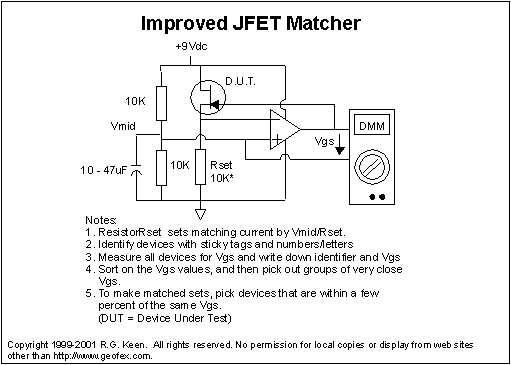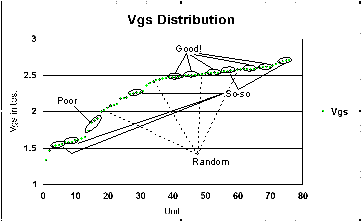| An issue that comes up all the time is matching JFETs.
People try to build effects using JFETs as a linear amplifier or as a
variable resistor (in all those phasers) and find that the effect
doesn't work as planned.
What's wrong is usually the variability of JFET characteristics. Compared to bipolar (NPN or PNP) transistors, JFETs vary all over the map. Here are some commonly used JFETs and their gate-source cutoff voltages:
Let's do some interpretation. This voltage is that voltage that causes the JFET to cut off completely - no current flows. The spec sheet is a guarantee that the manufacturer of the transistor makes to you. They will guarantee, for instance, that all J201's will cut off completely when you put -1.5V from the gate to the source of the device. They also guarantee that no J201's will cut off completely with less than -0.3Vgs. As long as the devices you get fall in that range, they are good parts (to this particular spec, anyway). So let's see... um... 1.5V divided by 0.3V... that's a five to one variation! That's terrible! Looking up the chart, things get worse. A 2N5484 varies from 0.3V to 3.0V, ten to one. If we look at the 2N4416A, we see that the variation is only a little over two to one... phew, finally a tightly specified part. Especially compared to the plain vanilla 2N4416, which specifies no minimum at all. By the way, where it says "not specified", the manufacturer is unwilling to say what the parameter is. If no minimum is specified, it's just that. The minimum turn off voltage might be zero - they won't say. And what does that 2N3819 "typical" mean? And how about those 2N3819's and MPF102's? They can't be guaranteed to turn off with less than 8V - a weak 9V battery can't turn them off at all. And the BF244 A, B, and C - three parts with overlapping minimums and maximums. What's happening there? What's going on is that the makers are coping with the inherent variation in the JFET process. It is much, much harder to make consistent JFETs than to make consistent bipolars devices. And unstated, but implied is that if they vary this much, then the testing to sort them into nice, tightly defined bins of parts would cost too much. That's what's going on with the BF244's - the maker has made batches of JFETs, shot at the middle of the distribution for the A, B, and C parts, and then tested them. BF244B candidates that didn't make the max -3.8V spec could at least be dropped in the BF244C bin. This makes our lives more interesting as effects makers. We often want to use a JFET as a variable resistor, particularly in phasers like the Phase 90. Since we know that a JFET has it minimum resistance when Vgs is zero and that goes to a maximum of almost infinite when the device is cut off, the ranges of Vgs off shown above correspond to the ranges of control voltages we have to put on the JFET gates to get them to be a variable resistor somewhere between Rdson (usually a few hundred ohms) and an open circuit. We usually want to put some control voltage on them and get some resistance variation. The range of the Vgs values is too large to cope with in most simple circuits without some further selection. That's what this little circuit does. The matcher sets up a middle-of-the-power-supply voltage on the left side with two 10K resistors, and then a JFET and another 10K resistor to compare to the reference voltage. The opamp's job is to compare the two voltages and make the voltage on the JFET gate just right so it looks like a 10K resistor (same voltage and current) in this setup. There's nothing magic about the 10K value for Rset, it's just a convenient value that's going to be about where a lot of our circuits will wind up.
So I did this for 76 2N5485's that I bought. I cut up a sticky-label into tiny rectangles, numbered the labels 1-76, and then measured them all. Once I did that, I typed in the 1-76 in one column of a table, and the measured Vgs from the matcher in the next column and sorted on the Vgs value. Any bets on what happened? The spec for Vgsoff is -0.5 to -4.0. Here's what I measured: Lowest: -1.342V. Highest: -2.72V There were two distinct groups of them, a cluster around -2.5V and another at about -1.6V. Here's a picture of the distribution.
They're sorted in order of Vgs, so the lowest Vgs is way over in the lower left corner. Places where two parts have almost the same Vgs in the tester will be a flat place. Places where they vary a lot will be steep, so we can recognize good matched sets by looking for flat places. Since most people want four matched devices for P90 style phasers, I looked for sets of four. I found four, maybe five well matched sets, all in the upper range of about 2.5-2.6V. There are a few more so-so matched sets that would probably be OK, and several badly matched sets that I'd use in a pinch. However - if you don't buy a bunch and match them, you'd probably get the widely distributed ones shown in the "by luck" set. Those will probably not work well as a phaser at all. A phaser needs JFETs that are all in the resistive range - not fully on or fully off- at the same time. With the raw luck set, as your LFO ran, it would turn JFETS on or fully off at different times, and you would not get much phasing. You can also use this setup to test JFETs for matching in the JFET doubler, or just to see how hard you have to drive it. If a JFET needs more than 4.5V to turn it off, you probably can't use it in a 9V effect, as you just don't have enough voltage left over after getting it biased.
As always, comments and corrections gratefully accepted! R.G.
|

